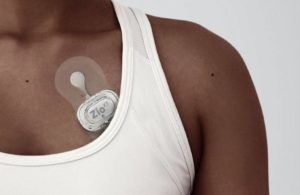
iRhythm (Nasdaq:IRTC) today announced the presentation of four studies reinforcing evidence behind its long-term cardiac monitoring.
San Francisco-based iRhythm presented the data at the Heart Rhythm Society’s annual meeting, Heart Rhythm 2023, in New Orleans. Data supports ambulatory cardiac monitoring of up to 14 days with the company’s Zio XT. It demonstrated increased diagnostic yield and improved diagnostic accuracy of ventricular arrhythmias across a variety of patient populations.
“These studies thematically showcase the value of iRhythm’s Zio products and services — in particular for identifying ventricular arrhythmias for risk stratification and disease management,” said Dr. Mintu Turakhia, iRhythm chief medical officer, chief scientific officer and EVP, product innovation. “The findings have important clinical and scientific implications, and they further demonstrate the strength of our technology across the complete range of clinical arrhythmias.”
Extended ambulatory ECG monitoring
iRhythm’s first study, the EXAMINE-HCM study, evaluated patients with hypertrophic cardiomyopathy (HCM). It found that long-term monitoring of up to 14 days with Zio XT substantially improves diagnostic yield of non-sustained ventricular tachycardia (NSVT).
Key findings included 48 hours of monitoring missing nearly two-thirds of patients with high-risk NSVT episodes. That may impact risk stratification and treatment.
iRhythm saw 18% diagnostic yield for detecting NSVT in the first 48 hours. It saw 48% at 14 days, with 63% of initial NSVT episodes occurring after the first 48 hours.
The company observed 8% diagnostic yield for detecting high-risk NSVT episodes in the first 48 hours. That compared to 24% at 14 days, with 64% of initial high-risk NSVT runs occurring after the first 48 hours.
iRhythm’s premature ventricular contractions (PVC) burden analysis
The company conducted a PVC Burden Analysis of 106,705 patients. It demonstrated the association of increased monitoring through at least 7-10 days duration with improved accuracy in the categorization of patients by PVC burden level.
iRhythm says the important findings demonstrate how misclassification could impact clinical decision-making.
A 48-hour estimation of PVCs misclassified PVC burden compared to 14 days of ambulatory ECG monitoring. At least seven days of continuous ambulatory ECG monitoring (performed by Zio) proved necessary to achieve greater than 95% accuracy in burden categorization.
Practice variation after ECG detection of NSVT
A retrospective study from the Veterans Health Administration evaluated 58,279 patients. A third of those patients who received long-term ambulatory ECG monitoring of up to 14 days with Zio had NSVT.
iRhythm said the findings highlight an opportunity to create risk models and integrated care pathways following ECG monitoring.
The study observed a wide, site-level variation in diagnostic testing and treatment in the VA healthcare system after detection of NSVT. That included the proportion of patients with echocardiograms, coronary angiograms, stress testing, cardiology care and the use of cardiovascular medications in the 90 days following ambulatory monitoring.
Evaluating flecainide in arrhythmogenic right ventricular cardiomyopathy (ARVC)
iRhythm conducted the Flec-ARVC study at the University of Rochester, the Johns Hopkins ARVC Program and other outside institutions.
The company said it marks the first randomized clinical trial evaluating flecainide in ARVC. iRhythm said the use of Zio services highlights its PVC burden measurement capabilities and its capabilities in clinical trials and research.
In the randomized, placebo-controlled crossover trial of 41 patients that received Zio XT service for seven days, flecainide significantly reduced PVC burden.